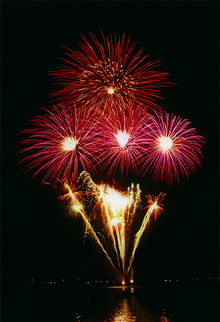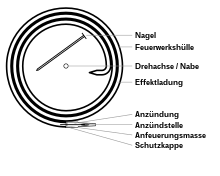Fireworks
As fireworks are pyrotechnic articles referred to that for fireworks serve -Zwecke. Fireworks do not include pyrotechnic objects that serve as emergency signals ( signal rocket ), for military use ( battlefield lighting ) or for technical experiments.
Types of fireworks
Fireworks display
Effect with rising heights between several dozen and a few hundred meters. In heaven such a height fireworks explode - caused by a bursting - and throw their effects (eg. Star Light , howler , salutes , Crackling star ).
Effect body with passive ascent
Effect bodies that are shot into the sky (bombs, etc.) are generally shot out of pipes ( mortars ) due to an ejection charge in the form of granular fireworks black powder :
- Ball bomb , a bullet- shaped projectile; it is the standard design for fireworks of Asian origin
- Cylindrical shell , cylindrical bombs that generate more capillary rise by their shape
- Bombette , a small effect that is built into a larger number in an overall effect
The shape of the actual effect is independent of the shape of the body. Cylinder bombs also create perfectly round effects ("chrysanthemum", "peony"), ball bombs also create rings ( ring bomb , "Saturn"), or figures such as "butterfly", " smiley " or "heart", as well as those following:
- A “weeping willow”, but especially the Japanese kamuro , or “crown”, “diadem”, “spider”, “polyp” and others describe a particularly long-lasting effect that only burns out a few seconds after cutting and therefore falls far down. Kamuros in gold are the classic final shots.
- “Comet”, “palm” or the like are effects that leave a trail of light during the ascent ( rising effect ). This additional flare is ignited at the same time as the propellant charge.
- Blitzknall , "Salut", a bomb with a lightning bolt phrase that mainly generates noise. The typical opening and closing shot. Italian and Spanish saluts have a special reputation.
Self-propelled effect body
Self-propelled effect bodies have a propellant that gradually burns down : The rocket is ignited and the propellant charge provides the rocket with thrust for a certain period of time . After that, the rocket only continues to climb through its inertia. The propellant charge consists of a mixture similar to black powder. A short time later, a delay set releases the ejection charge, which ignites and disperses the effects. Examples:
- Fireworks rockets
- An air howler is a firework that burns down after lighting, producing a loud howling sound and moves through the recoil. This fireworks has been banned in Germany since July 1st, 2008 because of its uncontrolled flight.
Ground fireworks
Fireworks that stand on the ground or are firmly anchored include:
- Fountains and volcanoes (also called sugar cane in Switzerland ) spray sparks and / or small stars upwards. The height of the effect varies between ten centimeters and several meters. As a waterfall fountain , they are attached to horizontal wires etc. with the nozzle pointing downwards; without a nozzle, a curtain of silver sparks falls to the floor.
- A sun is a wheel that is made to rotate on a rod by the recoil of drive bodies, usually combined with a spark effect like in fountains.
- Bengal pots: small floor-standing devices that produce Bengal light (e.g. for illumination purposes ). Common colors are red, green, yellow or blue / purple.
Mixed forms of ground and height fireworks
Fireworks that eject their effects upwards into the air, but do not only appear up high:
- Fire pot : Effect that emits loose effects directly: These form a column
- Tailpipe , comet pipe : single effect as pure ascent
- Battery ( cakebox ), a cardboard pack of different effects with a fuse , sometimes combined with other effects such as fountains. In the most extensive variant, in which several batteries are attached to a board and enticed together, called composite fireworks , battery composite or prefabricated fireworks .
Light, smoke and whistle effects
- Roman light , bomb tube
- Bengal fire ( Bengal light ), often in the form of Bengal torches
- Signal rockets , in a special form as a parachute signal rocket
- Smoke powder , smoke balls
These different effects are based - in addition to the mechanical construction of the body - on the compositions of the effect sets used (light and light effect set, smoke, whistle set).
Pure bang effects
- A cannon strike is a firework which, in its cylindrical version, consists of loose black powder packed in a cardboard tube and has a Bickford powder fuse (a variant of the safety fuse ) with a black powder head. There are also cubic cannon strokes that are held together in the shape of a cube on the outside with a cord. A cannon blow breaks apart with a loud bang, usually without any special lighting effects. Cannon strikes are now largely produced in China.
- Reibbkopfknaller , also Swiss cracker , pirate , enthusiasts : a mostly about large individual cigarettes bang with reaming to light at specific Reibbrettern or the rubbing surface of a matchbox .
- Chinese rattle cord : small bang sentences in a long, thin tissue paper sleeve. It burns in a rapid series of medium-loud bangs at about 1 m / min; We call it that because it is typical of the Chinese New Year .
- A firecracker is a firecracker, which consists of more effect sets, which burn over time. A crackling frog makes jumping movements, which is where the name comes from.
- Blast carpets , bang chains , carpet crackers or lady crackers as well as zissel men cause many individual bang effects, which are connected by a fuse , which, after being lit once, causes the individual bang effects to explode second by second.
Fireworks joke articles and fireworks toys (usually within EU category F1)
- Indoor fireworks can and may be used in closed rooms: crackers , table fireworks or sparklers .
- Crackers , bang pull cords , Crackling Balls trigger report effects; Small fountains, tiny volcanoes, gold or silver rain, etc. trigger lighting effects.
Fireworks transportation
Fireworks are class 1 dangerous goods (explosive substances), so you should note that, depending on the type, an ADR certificate and dangerous goods equipment are required for transport on the road, depending on the type . In addition, placards (8.1.3 in conjunction with 5.3.1.5 ADR) must be affixed to both long sides and at the rear of the transporting vehicle (except for subclass 1.4S) and no passengers may be taken. With fireworks of dangerous goods class 1.3G (UN-No. 0335) the limit of 20 kg can be reached quickly. The class of dangerous goods and the net amount of explosives must be indicated on the packaging of fireworks.
ADR regulation 8.5 "Smoking as well as the use of fire and naked light is prohibited on vehicles that transport substances and objects of class 1 in their vicinity and when loading and unloading these substances and objects." Since ADR 2015, "The smoking ban also applies to the use of electronic cigarettes and similar devices "
See also
For the legal situation in dealing with fireworks items, see:
- Fireworks on regulations on events
- Pyrotechnics for handling pyrotechnic objects in general
- Pyrotechnicians for training
- Explosives law to the legal norms in Germany, Switzerland and other countries
- Pyrotechnics Act becomes a legal norm in Austria
On the chemistry and physics of fireworks:
literature
- Urs von Arx: Fireworks. Environmental impact and safety aspects . 2014, Federal Office for the Environment . Environmental Knowledge, No. 1423.
Web links
- technik.feuerwerk.net , with Fireworks Wiki
Individual evidence
- ↑ Zuckerstock from Knallfred , accessed on July 31, 2014.
- ↑ The microcosm in pyromaniac intoxication , Jungfrau Zeitung , accessed on July 31, 2014.
- ↑ Information sheet (PDF) Carriage of fireworks by road , accessed on January 7, 2017.
- ↑ Overview of the innovations as a tabular comparison of ADR 2013 vs. ADR 2015; Status: October 17, 2014, Publication BGBl, Part II





